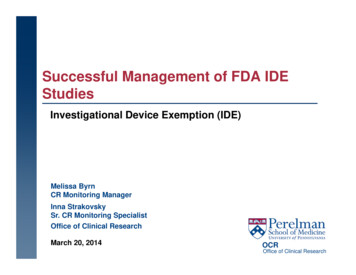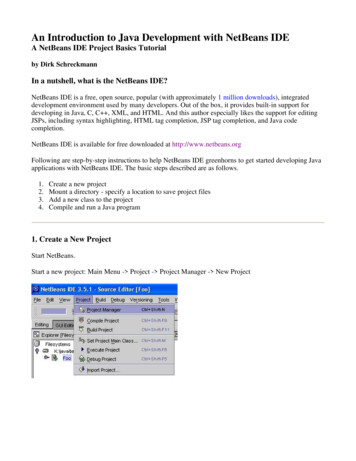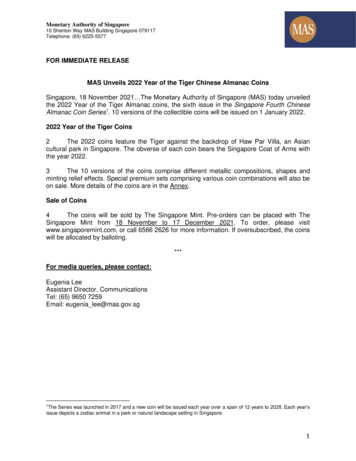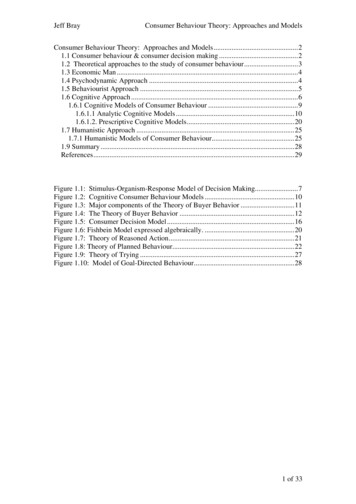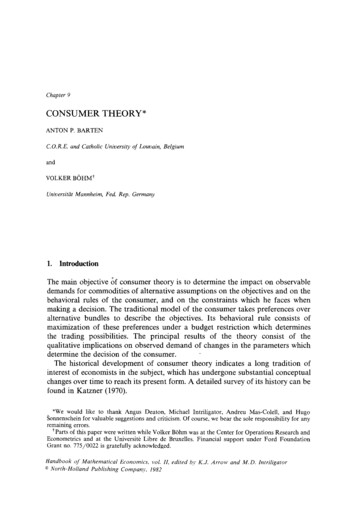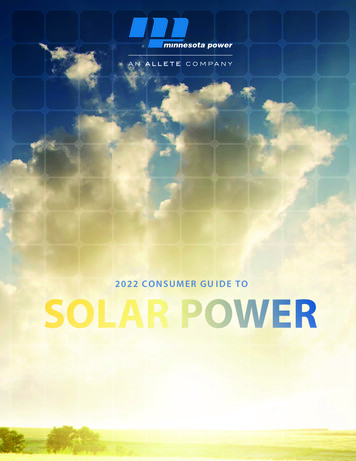
Transcription
2022 CONSUMER GU IDE TOSOLAR POWER
mnpower.com/environment/EnergyForwardEnergyForward is how we are doing our part to provide safe,reliable and clean energy while helping to transform the wayenergy is produced, delivered and used. We’re strengtheningthe electric grid that delivers energy to homes, businessesand industry. We’re generating more power from renewablesources like the wind, water and sun. And we’re helpingcustomers find ways to understand, manage and reduce theirenergy use.
2021 CONSUMER GUIDE TO SOLAR POWERTABLE OFCONTENTS3HOW DOES SOLAR WORK?46THE PARTS OF A PV SYSTEMIS SOLAR RIGHT FOR ME?6SOLAR RESOURCE6EFFICIENCY FIRST8SITE ASSESSMENT9COST OF SOLAR10WHERE DO I START?115 STEPS TO SOLAR14NET ENERGY METERING15UNDERSTANDING YOUR NTERCONNECTION PROCESS FLOW22APPLICATION PROCESS24SAMPLE APPLICATION40CERTIFICATE OF COMPLETION42SOLAR ENERGY ANALYSIS PROGRAMThis guide is intended for solar PVsystems 40 kW and under. ContactMinnesota Power for information regardingsystems larger than 40 kW, as there may beother considerations.
ENERGY FROM THE SUNMinnesota Power has long encouraged the adoption of renewable energy such as solar. Webegan offering rebates for customer-owned solar energy systems through our SolarSenseprogram in 2004. Today, as interest in capturing energy from the sun increases and the costsassociated with solar power decrease, we continue to help customers understand how theyuse energy and how to get the most value from their energy investments.This guide will help you learn how you can use the sun to power your home or business andwalk you through the process of installing a solar photovoltaic system.2
2021 CONSUMER GUIDE TO SOLAR POWERHOW DOES SOLAR WORK?Solar power is energy harnessed from the sun’s rays. We can make use of that energy inthree main ways: passive, thermal, and photovoltaic, or PV, systems.Passive solar energy systems use building design tomaximize or minimize the energy found in sunlight forheating, cooling, and lighting. Solar thermal technologiesuse the heat energy from the sun to heat water or air. SolarPV systems generate electricity directly from sunlight by wayof solar panels. While all of these are available in our region,this guide focuses on solar PV systems.or AC, that can be used to serve the electrical needs in yourhome or business.There are three main types of solar PV systems: grid-tied,grid-tied with battery backup, and stand alone. Grid-tiedand battery backup systems are by far the most commonlyinstalled solar PV systems in the market today. Customersconsidering a stand-alone solar PV system should workwith their solar installer to ensure that the system is sizedand sited properly to meet their electrical needs. Costs andmaintenance requirements vary among these three systems.The panels used in PV systems are made up of solar cells thatconvert sunlight into electrical energy in the form of directcurrent, or DC. That energy is then routed into an inverterwhich converts the energy from DC to alternating current,Grid-tied (PV) system Most common. Least expensive. Requires least maintenance. Connects directly to the electric distribution grid. Produces electricity used to power the loads in yourhome or business. Any excess energy is sent back intothe utility grid to be used elsewhere. Automatically disconnects when there is an outage inorder to prevent damage to equipment or personnel. Batteries aren’t typically meant to power an entirehome for a long period of time.Grid-tied with battery backup system Less common than standard grid-tied systems. More expensive than standard grid-tied systems. Requires more maintenance. Has a battery component that allows it to continuefunctioning when there is a utility grid outage.Commonly installed when there is a need to back upcritical loads. Has additional interconnection requirements. Commonly used in remote areas where the cost ofbringing utility power to a site is very high. Must be carefully planned to match the home’s energyneeds to the system’s size and storage capabilities.Stand-alone system Least common type of PV system. Most expensive of the three types of PV systems. Operates independently of the grid.3
THE PARTS OF A SOLAR PV SYSTEM1234Solar PV systems capture sunlight and convert it into electricity that can be used to poweryour home or business. Basic grid-tied solar systems consist of solar panels, inverters,racking, meters and disconnect switches. Optional components include monitoringsystems and batteries.1 Solar panels or modules. Individual solar cells areconnected in groups called panels or modules. When the sunhits a solar panel, it allows photons, or particles of light, toknock electrons free, creating a DC flow of electricity. Thereare three main types of solar panels:Monocrystalline. These panels have the highestefficiency due to the process of forming the siliconcrystals. Because of their high efficiency, they arealso more expensive than other solar panel technologies available today. This technology is ideal forroof-mounted systems because it is the most spaceefficient. You need fewer panels to produce the sameamount of energy as other types of solar panels.Polycrystalline. Polycrystalline solar panels are createdusing a less-intensive method of forming the silicon4crystals. They tend to be slightly less efficient thanmonocrystalline panels but also cost less.Amorphous or thin film: These panels are relativelyinexpensive to produce but also have the lowestconversion efficiency of the solar panel technologies.Some amorphous panels are flexible and can be usedin a variety of applications. This technology is suitablefor large rooftops or open fields because it takesmore thin-film panels to produce the same amount ofelectricity as traditional silicon panels.2 Inverters. The DC electricity generated by solar panelsis converted into AC by inverters. All grid-tied inverters aredesigned to disconnect from the utility grid when the utilityexperiences a disruption in power because of an unexpectedoutage or scheduled maintenance. Two main types ofinverters are used in grid-tied solar applications:
2021 CONSUMER GUIDE TO SOLAR POWERString Inverter. String inverters are the most commonlyused inverter for grid-tied PV systems. They allowthe electricity output from multiple modules to beconverted from DC to AC at the same time. Althoughthey may be built to handle Minnesota’s harsh weather,they are likely to last longer and perform better in aprotected environment.Microinverter. With these inverters, the conversionfrom DC to AC takes place at each individual solar panel.The inverters are affixed to the back of each panel andcontrol only that panel. Microinverters can diminish theeffects of shade on a PV system’s total output becauseeach solar panel has its own microinverter. If only onesection of the solar array is shaded, it won’t affect therest of the system’s output. Since these inverters areconnected to the solar panel, easy access to the panelsneeds to be maintained.3 Meters. Installing a solar PV system requires exchangingyour current meter for a bidirectional meter and installing asecond meter for measuring the production from your solarPV system.Bidirectional meters record the energy that youpurchase from Minnesota Power minus the energy thatyou sell to Minnesota Power to get your net usage. Thenet usage could be a positive number, meaning youused more energy than your solar system generated.Or, the net usage could be a negative number, meaningyour system generated more energy than you used andthe excess was sold to Minnesota Power. Informationfrom this meter is used for billing and allows MinnesotaPower to credit your account for excess generation thatyour system produces during the billing cycle.Production meters track the actual amount of electricityproduced by your solar PV system. It is not used forbilling purposes. Minnesota Power will provide theproduction meter and meter socket to customersinstalling a grid-tied solar PV system. However,ownership of the meter socket will be transferred to thecustomer and any future meter socket maintenance willbe the customer’s responsibility. The production metermust be installed within 10’ of the bidirectional meter.4 Disconnect Switches. These switches are required on allthe DC side of the inverter and is often integrated into theinverter. Another disconnect is required on the AC side ofthe inverter. The disconnect switches allow utility and firesafety personnel to verify that the system is safely disconnected from the utility grid while performing maintenanceor responding to an emergency. Minnesota Power requiresthat a disconnect switch on the AC side of the inverter bea visible open, lockable disconnect located within 10 feetof the utility meter. This allows the disconnect switch to bereadily accessible at all times.Other Parts of a PV SystemRacking. PV modules are attached to the roof of a buildingor to a ground-mounted structure with racking. Considerwind and snow loads when choosing the racking methodfor your system. Ground-mounted “tracking” systems alsoare available. They use motors to track the sun throughoutthe day and move the solar array for optimal sun exposure.While trackers do increase the production, they also increasethe cost of the system and are more susceptible to malfunctioning parts.Balance of System. Many small parts are needed tocomplete a PV system. This can include wires, conduit,junction boxes, and wire management. Costs for thesecomponents can range significantly and depend on theunique circumstances of each installation.Monitoring Systems. An optional component, monitoringsystems can usually be added to your solar PV system for afee. These can typically be purchased through the invertermanufacturer, your installer, or a third-party vendor andallow you to see performance metrics of your system. Someof this information may also be available on your inverter’sdisplay screen. Many inverter manufacturers includemonitoring as a part of the inverter purchase.Batteries. In grid-tied systems, batteries may be used asoptional backup power. During a power outage, basicgrid-tied systems are designed to automatically disconnectfrom the grid, meaning the customer would be out ofpower. Battery backup systems allow the solar PV system todisconnect itself from the utility grid but continue to operateusing energy stored in the batteries. Battery-based systemsare more expensive and require more maintenance thanbasic grid-tied systems.grid-tied solar systems. One disconnect switch is located on5
2021 CONSUMER GUIDE TO SOLAR POWERIS SOLAR RIGHT FOR ME?Reasons for investing in solar energy are as individual as each customer. But whatever yourmotivation, you’ll want to consider how much sun is available at your site and how much asolar installation will cost.SOLAR RESOURCESolar resource refers to the amount of solar energy availablein a given area and is measured in two ways: irradiance andinsolation. Solar irradiance is the amount of instantaneouspower that falls on a given area at a single point in timewhile solar insolation measures the irradiance over a definedperiod of time. Installers use solar insolation to help predictthe output of a PV system.customers to enter their location and the size of theirproposed PV system. It then uses local weather data andinformation about the proposed system to determineestimated production and energy value. Find the calculatorat pvwatts.nrel.govWhile it is true that Minnesota does not have the best solarresource in the country, you may be surprised to learnthat we do have a solar resource similar to some areas inTexas and Florida. It is also important to note that solar PVsystems can actually perform better in cooler climates likeMinnesota.Many tools are available to help customers calculate howmuch electricity a PV system is expected to produce.PVWatts, for example, is an online tool developed bythe National Renewable Energy Laboratory that allowsENERGY EFFICIENCY AND THE PYRAMID OF CONSERVATIONComplexity/InvestmentBefore deciding to install a solar system, you should first reduce theWindamount of energy your home or business uses. Energy efficiency is lessSolarRenewable OptionsElectricexpensive than energy production so making your home or businessWindowsReplacementmore energy efficient will reduce the size and cost of the solar PVFurnaceswithECMssystem that is needed. Minnesota Power offers tools, such as theHeating & CoolingHeat Pumps A/CPyramid of Conservation, to help customers understand howDrain Water Heat RecoveryWater HeatingSmartPakSolar Thermalthey use energy and make informed decisions about theirAttics Wallsenergy investments. Start at the base of the pyramid withInsulation & VentilationFoundationsCrawl Spaceslow-cost or no-cost energy efficiency upgrades andRefrigerators Dishwashers Clothes WashersAppliancesAppliance Roundup Dehumidifierswork your way up to more expensive or more complexSealing Bypasses in Attics, Walls & FoundationsAir Sealingenergy investments, such as renewable energyCaulking and Weatherstripping Windows & Doorsoptions like solar.LightingCFLsFixturesLEDsLearn more about energy efficiency and findtools for reducing your energy usage at:www.mnpower.com/energyconservationTemperature Settings/Programmable ThermostatsHot Water SettingsHome Entertainment CentersComputersUnplug Portable DevicesRoutine MaintenancePower of One PortalAction PlanTips and ToolsOn-Site Analysiswww.mnpower.com/powerofonehome6Online ResourcesNew Construction DesignLow-Cost No-CostUnderstandingCopyright 2008, 2011 Minnesota Power, an ALLETE Company, All Rights Reserved.
While it may seem logical that moresun shine means more solar power,this is not always the case. In someareas, such as the Southwest, the sun’sintensity actually hinders the oper ationof rooftop solar panels. In fact, with thesame amount of sunlight, solar panelsin cooler areas generally produce moreelectricity than those in locations withintense heat.Edison Electric Institute, www.eei.orgCOMMUNITY SOLAR GARDEN — ANOTHER CUSTOMER OPTIONMinnesota Power’s first community solar garden, is generating electricity and is a simple way for customers to participate in solarwithout the need to install a system on their own home or business. It’s a safe, flexible and convenient choice for customers whowant to go solar but either rent or don’t have a location that is well-suited to generating electricity from the sun. You can learnmore about this option on our website at: www.mnpower.com/CommunitySolar7
2021 CONSUMER GUIDE TO SOLAR POWER3214SITE ASSESSMENTWhen planning the location and design of your solar PV system, it is important to conducta site assessment to identify specific conditions that can affect energy production andoverall system design. Shade, orientation, roof characteristics, utility interconnection,aesthetics and accessibility all play a role in the design and cost of the system and shouldbe identified by your installer upfront.1ShadeShade can make a big difference in how much energy a PVsystem produces. The shade cast by trees, nearby housesor buildings, chimneys and even power lines should all beconsidered when deciding where to locate your solar system.Tools such as the Solmetric SunEye and Solar Pathfinder canidentify where shade will occur at different times throughoutthe year and are used by installers during a site assessmentto develop a shade analysis. In addition to existing obstructions, it’s important to think about the possibility of developments or structures that could shade your PV system in thefuture. Generally, an ideal site for producing solar powershould be free of almost all shade from 9 a.m. to 3 p.m.2OrientationWhether your system is roof or ground mounted, you willneed to consider the orientation of your solar PV system.Orientation refers to the azimuth, or direction that themodules face, and the tilt, or angle of the modules. In our8region, the ideal orientation for maximum output is when thearray faces south, or at a 180 degree azimuth, with a tilt angleof 45 degrees.3Roof ConditionFor roof-mounted systems, you will want to consider yourroof’s condition and structural integrity before installation.Solar PV systems will add a variety of stresses to your roof,including additional weight. Any necessary roof maintenanceshould be done before or in conjunction with the installationto avoid having to remove the system later to make repairs.4AccessibilityLocate your PV system in such a way that it is easily accessiblefor routine maintenance such as removing snow or cleaningmodules, troubleshooting performance issues or replacing wornor damaged parts. Roof installations also must meet all clearancerequirements in order to avoid potential hazards.
SOLAR ENERGY ANALYSIS PROGRAMA Solar Energy Analysis (SEA), free for Minnesota Power customers, is a great way to get more information about whethersolar power is a good fit for you. During an SEA, a representative from Minnesota Power will visit with you about your home orbusiness, analyze your site, help you understand the interconnection process and point out site-specific conditions that couldaffect an installation.Contact Minnesota Power at 218-355-3720 or renewableprograms@mnpower.com to schedule a Solar Energy Analysis. Formore information about the Solar Energy Analysis program and a sample SEA summary, see Appendix page 30.UTILITY INTERCONNECTIONIn a grid-tied system, you must apply for connection tothe utility’s distribution grid. The application should besubmitted early in the process to ensure that utility requirements are incorporated into the system design. In addition,your interconnection application must be approved byMinnesota Power before the system is installed. Systemsinstalled prior to obtaining approval from Minnesota Powerare done at the risk of the customer.COSTThe costs of solar PV systems vary depending on technology,system type, and size, and are typically referred to as hardcosts and soft costs. Hard costs are the actual PV systemcomponents such as solar modules, inverters, disconnectswitches, wires, conduit and meters. The soft costs refer tothe customer acquisition costs, installation time and labor,travel and local permitting or application fees. These twofigures together represent the total installed cost of thesystem which is typically expressed as /watt.The cost to install solar has dropped dramatically over thelast decade, making solar more cost effective than ever.According to the Lawrence Berkeley National Laboratory,the cost of a solar PV system in Minnesota has dropped frommore than 9/watt to an average of 3.20/watt today.1Despite the declining costs, solar PV systems remain a largeinvestment and usually require a sizeable upfront payment.We encourage you to consult multiple installers and exploredifferent manufacturers and products in order to ensure thatyou are getting the most competitive price for your system.Tracking the Sun 10: The Installed Price of Residential and NonResidential Photovoltaic Systems in the United States, Sept. 2018.19
WHERE DO I START?Installing a solar PV system is a collaborative process. The customer, installer, electrician,local inspector and Minnesota Power should work together to ensure that the PV systemoperates safely and reliably. Involving Minnesota Power early in the process will help youunderstand the interconnection process, as well as the standards and requirements forinstalling a solar PV system connected to Minnesota Power’s electric grid. Ensuring thatthese requirements are incorporated into the design of the system before construction willhelp you save time and money on your investment.INTERCONNECTION REQUIREMENTSTo ensure safe installations, all grid-tied PV systems must meet relevant provisions of the National Electrical Code (NEC), theInstitute of Electrical and Electronics Engineers (IEEE 1547), Minnesota Statute 216B.164, Minnesota Rules Chapter 7835 andelectric utility requirements. Installations must also comply with all local permitting and zoning codes, fire codes, buildingcodes, safety codes and local and federal laws, rules and requirements. The customer is responsible for ensuring that theinstaller follows all applicable rules and codes, including Minnesota Power’s interconnection process and requirements.For more information about specific interconnection requirements, visit www.mnpower.com/distributedgeneration10
2021 CONSUMER GUIDE TO SOLAR POWER5 STEPS TO SOLARContact Minnesota Power as soon as possible after you decide to go solar. We’ll help youstart the important interconnection process and identify some key factors to keep in mindas your installation gets underway. Follow these steps to install and connect your systemand you’ll be on your way to generating your own clean energy!Select an installerHiring a qualified solar installer is key to getting an efficient system and the most value from your investment.Installing a solar system should be treated the same as any major construction project: get multiple bids to ensurea competitive price, request references from past customers and review systems already installed to gauge theinstaller’s experience. In addition, review your energy consumption and talk with your installer about your usage.Understanding trends in your energy consumption may affect the design of the system you choose to install.Solar installers typically conduct a site assessment that includes a visit to your home to analyze potential shadeissues, orientation of the system, size and pitch of your roof and other factors. The assessment may be offeredas a free service or you may be charged a fee. Installers may provide other services, such as facilitating theapplication process and securing permits, as part of their offer. Some installers may also include a warranty on theirworkmanship. Be sure to ask what types of warranties are available when comparing installers and what post-installation factors may affect the warranty.Questions to ask your installer:»Are you certified with the North American Board of Certified Energy Practitioners (NABCEP) or do you holdany other nationally recognized solar installer certifications? Minnesota Power requires a NABCEP or ULcertified installer to qualify for rebates under its SolarSense program.»Do you have any experience working with local building officials and utility representatives?»Can you provide references from previous customers?»Do you offer a warranty on the installation?»What is the expected output of the system and who is responsible if the expectations are not met?»What is the cost per watt on this proposal? Be sure to get quotes from multiple installers to compare.»What is the warranty period of the equipment and the installation? There are equipment warrantyrequirements to participate in Minnesota Power’s SolarSense program but you should also be sure thatyour installer has a warranty on the installation of the system.»What type of down payment or deposit is required and under what terms (refundable, non-refundable)?11
2021 CONSUMER GUIDE TO SOLAR POWERSubmit an Interconnection ApplicationOnce you have selected a solar installer and designed a system that meets your needs, the next step is to submitan application to Minnesota Power for connecting your system to the distribution grid.Make sure your application is complete, including a one-line diagram of the planned system, site drawing,equipment specification sheets, and any other required information in order to ensure a timely review. Installersoften will complete the interconnection application for you but because the interconnection agreement isbetween you and Minnesota Power, it’s important that you understand the requirements and what is beingsubmitted. You must submit a MnDIP application for all interconnections. If you are applying for SolarSenserebates, a supplemental application is also required. A 100 application fee applies for each application and maybe submitted to Minnesota Power by check to: Renewable Programs 30 W Superior Street, Duluth, MN 55802.Preliminary ReviewOnce you have submitted a complete interconnection application, Minnesota Power will conduct a preliminary review.A Minnesota Power representative will come to your site to assess the planned system and your current service toidentify site-specific conditions that may affect the installation. During the preliminary review, equipment fromthe utility transformer to the customer’s service equipment will be evaluated. This evaluation includes, but is notlimited to, meter sockets, transformers, weather heads and clearance issues. If any hazards are identified, you willbe notified at this time. Minnesota Power will work with you to understand the hazards, evaluate ownership andcost details of the issues in question, and identify possible solutions.The preliminary review process allows Minnesota Power to ensure that all distributed generation systems areinstalled in a safe, consistent and reliable manner. It is important that you do not begin construction of yoursystem until the preliminary review is completed and approved.InstallationYou can begin building your PV system after receiving approval from Minnesota Power.All solar PV systems must be inspected by a state or local inspector after they are completed and before beingenergized. After the system has passed an electrical inspection, contact Minnesota Power to schedule the finalcommissioning test. This test allows Minnesota Power to verify that the system was installed as planned and thatthere are no safety concerns relative to the interconnection.If there are any changes to the system components or design during the installation process, notify MinnesotaPower prior to installation. Changes may require you to submit a new interconnection application and restartthe process. It is important for changes to be approved to ensure the system passes the commissioning test andtimely interconnection can occur.Connect to Minnesota PowerThe final step is to connect your system to Minnesota Power’s distribution grid.Once your system meets all commissioning requirements, your existing meter will be exchanged with a bidirectionalmeter, a production meter will be installed, and your rate will be changed, generally to a net energy metering rate.The bidirectional and production meters will not be installed until all commissioning requirements are met.We encourage customers to be cautious about installing solar systems in the fall and winter because snow and frostcan complicate the process and even increase installation costs. Be sure to give yourself plenty of time in order toavoid weather-related issues.12
A typical solar module comes in twosizes, 60 or 72 cell. They are about18–22 square feet, weigh about45-55 pounds, and are rated toproduce about 300-400 watts.13
NET ENERGY METERINGDepending on the size of the system that you choose to install, you may be eligible for netenergy metering, also called NEM. NEM is a rate offered to Minnesota Power customersthat credits the customer’s account for any excess electricity that the PV system generates.A solar PV system may produce more or less electricity than is needed in your own home or business at any given time duringthe month. When your system produces more energy than you need to meet your own needs, the excess energy is sentto Minnesota Power. If you produce more than you use in a billing month, you receive a credit for the excess production.Likewise, if your system does not produce enough electricity to serve your needs, you will be able to take energy from thegrid at the current rate.Because you could be taking electricity from the grid and sending electricity to the grid, you will need a special meter thatcan track energy forward and backward. This bidirectional meter must be installed by Minnesota Power before your solar PVsystem is energized so your system’s production can be properly credited.WHY IS THE GRID IMPORTANT?The grid refers to the poles and wires that deliver electricity to your home or business. All customers must pay to build,operate and maintain the grid infrastructure to ensure a safe and reliable energy supply.Customers with grid-tied solar PV systems use the grid 24 hours per day, whether they are using it to purchase electricity or usingit to sell excess electricity through net energy metering.Production from a PV system rises and falls with the sun. During the night when solar panels aren’t generating, you’remeeting your power needs by drawing electricity from the grid. During the day, as electricity production increases, there maybe times when your system produces more than enough electricity to meet your needs and excess power is sent onto thegrid. Either way, a grid-tied solar system uses the grid 24 hours per day.14
2021 CONSUMER GUIDE TO SOLAR POWERUNDERSTANDING YOUR BILLInstalling a solar PV system will mean a change in how you are billed. Under NEM, you will continue to purchase electricity fromMinnesota Power at your current retail rate. You will also be credited at the average retail rate if your solar system produces moreenergy than you consume during the month. Based on whether you’re using more energy than you’re producing or vice versa,your bill may look slightly different. The sample bill below depicts how your bill will look if you are using more energy than you areproducing during the month. Please contact Minnesota Power with any questions about your bill at 218-355-3720.Bill Number: 123Bill Date: January 14, 2019Name: Joe John1 Account: 000000250 ROCK RDDULUTH MNMeter #EMP55555Start Date Start Read12/09/201810589Residential Co-Generation Net Metering: 20CG31 DaysReadReadCodeEnd DateEnd ReadCodeRegular 01/09/201911367RegularBilled for the Last 24 Months1500841000KWH10125000Jan 20175Jan 2018This BillNext Scheduled Meter Read: 02/08/20193Total
Power to credit your account for excess generation that your system produces during the billing cycle. Production meters track the actual amount of electricity produced by your solar PV system. It is not used for billing purposes. Minnesota Power will provide the production meter and meter socket to customers installing a gri
